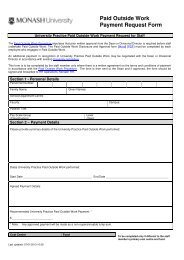MONASH UNIVERSITY <strong>GAZETTE</strong>It is interesting to note that the response from theblue-collar group was almost equal to that of the whitecollargroup, and both were only a little below that ofthe middle-class. This is contrary to the response ratesrecorded from other studies where the blue-collar group.with the lowest level of <strong>edu</strong>cation, has the lowest responserate.The coding of this questionnaire, even though most ofthe questions asked were "closed" questions (that is,asked for a response from amongst a predetermined listof answers or for a simple "yes" or "no"), proved tobe a more laborious task than expected and was notcompleted until July. The first preliminary frequencycount is now available but the full statistical analysisof the data is not yet completed.The histogram below gives the income break-down ofthe first sample from the south-eastern suburbs.··~ I· •n, ,n.,.",.jIncome per week in dollars ($A) of heads of householdfrom a sample from three south-eastern MelbournesuburbsTELEVISION DEVELOPMENTSOne of the features of the <strong>University</strong> has been the useof television equipment on the campus, and progress inthis field has been reported by the Audio-Visual AidsOfficer, Mr. E. C. Snell.The <strong>University</strong> television equipment, although situatedin the medical school, is available for use anywhere onthe campus. If a high quality signal is to be videotaperecordedfrom an area where no cables exist, a microwavelink system is used to transmit signals from themobile television unit to the roof of the medical school,then down to the videotape recorder.There are a number of cables which connect themedical school to the Menzies building. These cablesare designed to carry the picture, sound and intercommunicationsignals. Additional cabling was recentlyinstalled between the Menzies building, circular lecturetheatres and the Alexander Theatre. The next cableinstallation will be to the law school and the mainlibrary has also been asked to consider the installationof permanent cabling.It is therefore possible at the present moment tooriginate a telecast from any point on-campus, transmitit via the microwave link to the medical school and thento any of the existing outlets in the Menzies building,circular lecture theatres or Alexander Theatre. The cableis designed to operate in both directions.DEVELOPMENT OF WATERRESOURCES AND RESEARCHBy T. A. McMahon, Lecturer, Department of CivilEngineeringPlanning is stimulated by crisis. The recent droughts inVictoria and New South Wales are no exception in thisregard, and considerable discussion has occurred in thenational Press and elsewhere on how the effects of suchoccurrences can be minimized in the future. In Melbourne,many citizens have expressed their opinionsconcerning the crisis last summer. In view of this itseems appropriate to comment on several issues relatingto the development of water resources.While within the Australian environment the vagariesof Nature are an ever-present problem, particularly inregard to variability of rainfall and streamflow, a moresubtle problem which, in some regions, has alreadyconfronted planners and politicians, is competitionamong users for a limited water resource. In 1962, theMelbourne and Metropolitan Board of Works suggesteddiverting water from the Big River, north of the Divide,into the metropolitan system. Inevitably, agriculturalinterests opposed the scheme and - it would seem forpolitical expediency - the MMBW was directed to seekadditional supplies south of the Divide. In this context•it is worth noting that in Victoria we me annually morethan 2,500,000 acre-feet of water. Eighty-five per centof this is channelled to agriculture and the remainderis used for domestic and industrial purposes.To-date, in Australia, political action has temporarilyforestalled any crisis developing in the competition forwater supplies and, consequently, research programmesin water resources allocation techniques are not receivingsufficient attention.In the meantime. however, water <strong>au</strong>thorities are developing,as funds become available, the supplies attheir disposal and at the same time are making a continuingassessment of demand and supply for water inan attempt to rationalize distribution. For this to besuccessful, planning should be carried out at two levels.The first should be based on projections into the nearfuture, say five to ten years, during which it can beconfidently predicted that the present trends, adjustedfor changes in technology, can be reliably extrapolated.On the other hand, in order that an overall objectiveor master-plan can be formulated, a longer planningperiod is also required. In our present circumstances, aperiod extending to the year 2000 seems appropriate.On examining urban water needs, two general problemsare evident. Firstly, there is one associated withgrowth. In most circumstances, not only do we find anincrease in population and, hence, more water required,but also with increasing affluence an increase in percapita consumption. This feature is dramatically shownin the accompanying graph of Newcastle's water usage.Per capita consumption has increased from twenty galIons per day in 1900 to 130 in 1965. Nearly two thirdsof this is used in and around the house. The significantreasons for this tremendous growth are not clear. Incontrast, a similar analysis for Melbourne shows an entirelydifferent picture; consumption from 1900 to 1965increased from 55 gallons per day per capita to only 80.In view of these differing consumptive rates, and bec<strong>au</strong>se32
projections of water requirements are based on percapita estimates, a study has been initiated in the departmentof Civil Engineering at <strong>Monash</strong> <strong>University</strong> to'"1040,.. ",,120 ., '100, :/', :'\ :... :' 'I \110 " ~~I/o"00,t20 1140Per capita domestic and industrial water consumptionin gallons per day for Melbourne and Newcastleno.ooor100.000scnce /., , . ,"'...,/2S,000""1000 L __~1.00 1120 1940 lUOYearly domestic and industrial water consumption inacre-feet for Melbourne and Newcastledetermine the more important factors affecting domesticand industrial per capita water use.The diagram showing Melbourne's water consumptionpoints to a second difficulty associated with Australianurban water resources planning. Can water engineerscontinue to provide a relatively low-cost supply tometropolitan population centres which require increasinglygreater volumes of water each year? By extrapolatingthe graph for Melbourne, we can estimate thatthe per capita daily consumption in the year 2000 will bearound 105 gallons. Coupled with a population of, say,5,000,000 people, this means that about 700,000 acrefeetof water will be required per year by the end ofthis century. (For present purposes, the assumptionsassociated with making this estimate can be ignored).Until now, Melbourne has relied upon the Yarra basin,which has a mean annual flow of' approximatelyI,000,000 acre-feet, to provide her water needs whichare currently about 250.000 acre-feet per year. Firmproposals have been put forward by the MMBW to gainadditional water from the Yarra and to extend the supplyareas to the Thomson catchment in Gippsland which isa potential source of 500,000 acre-feet per year. Thus,within the next few decades adequate water can bemade available for our garden city but, bec<strong>au</strong>se themost economic dam sites have already been utilized,additional supplies will be more costly to the taxpayer.This factor could force the community into a morerealistic approach towards accepting reclaimed wastewater rather than developing high-cost 'pure-source'supplies.In water-supply schemes, whether these be for domesticand industrial usage or for irrigation, the optimumsize of the headwater storage is a critical factor. Asecond current project within the Civil Engineering departmentis concerned with theoretical and practicalaspects of estimating required reservoir capacities tosatisfy a given demand. An important considerationrelating to this concerns the .level of reliability associatedwith the specified demand. Unfortunately, critics ofpublic projects often overlook this essential feature. Itis important to keep in mind that a water resourcessystem, whether it be constructed as a flood-mitigationscheme or as a conservation measure, will have someelement of risk associated with the functions for whichit is designed. Thus, in public works projects, andparticularly in the case of water supply, r<strong>edu</strong>cing therisk of failure inevitably entails greater costs for thetaxpayer.A fundamental requirement in designing a waterresourcessystem is a knowledge of the temporal andspatial streamflow patterns and their significance in thehydrologic cycle operating within the area. More oftenthan not, streamflow information is not available at agiven location. and hence the water-supply engineer isforced either to compute deterministically a sequence ofdata which approximate past records, or to generate bya stochastic (that is, probabilistic) proc<strong>edu</strong>re, a seriesof events which is assumed to represent the likelyvariations of future flow.Modelling the rainfall-runoff process using a digitalcomputer is the subject of a third research project. It ishoped that not only will the model be a means of computingstreamflow records from rainfall information butalso that it will allow a deeper insight into the hydrologicprocesses operating within a river basin.33
















